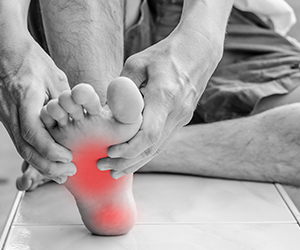Patient Education
We believe that the more you know, the better our doctors can help you!

Frequently Asked Questions
Do I need a Referral?
While our office does not require a referral, your insurance company may. Medicare (Red, White & Blue Card) and PPO's never do. However, HMO plans almost always do.
When Should You Call a Doctor?
You SHOULD see a doctor immediately if you show any of the following symptoms:
- You have persistent pain in your feet or ankles.
- You have noticeable change to your nails or skin.
- Your feet are severely cracking, scaling, or peeling.
- There are blisters on your feet.
- There are signs of bacterial infection, including:
- Increased pain, swelling, redness, tenderness, or heat.
- Red streaks extending from the affected area.
- Discharge of pus.
- Fever of 100°F (37.78°C) or higher with no other cause.
- Symptoms that do not improve after two weeks of treatment with a non-prescription product.
- Spreading of the infection to other areas.
- Your toenail is getting thicker and causing you discomfort.
- You have heel pain accompanied by a fever, redness (sometimes warmth) or numbness or tingling in your heel, or persistent pain without putting any weight or pressure on your heel, or the pain is not alleviated by ice, aspirin, (or ibuprofen or acetaminophen).
- You have diabetes or certain diseases associated with poor circulation and you develop athlete's foot. People with diabetes are at increased risk for a severe bacterial infection of the foot and leg if they have athlete's foot.
Do I Need A Referral To See A Podiatrist?
It depends. You typically do not need a referral to see a Podiatrist. Medicare and PPO type plans never require a referral. However, HMO type plans almost always require a referral. Podiatrists are regarded as specialists, so if your insurance company requires a referral to see a specialist, then you will need to get a referral from your primary care doctor. Just let them know you have a foot and ankle problem, and that you want to see a podiatrist. We are on most insurance plans, however if you are not sure, please call the office and we will verify what your insurance requires. If you have any concerns about your feet and/or ankles or you're just after some advice, call our office today.
How Long Does It Take To Get An Appointment?
With four podiatrists and four locations, we can typically offer appointments within 24 hours and we offer immediate care for medical emergencies.
Does Thomas Podiatry And Associates Take My Insurance?
We accept all insurances, including Medicare.
How Often Should I Change My Orthotics ?
While orthotic devices can last anywhere from 5 to 10 years, it is recommended that you get a biomechanical exam every 2 years to assure your orthotics are still doing the best job at supporting your feet. As we age our body goes through natural changes, like the tightening of ligaments, which can change the structure of the foot, this is why it is a good idea to periodically have you feet and orthotics evaluated.
Should I See A Podiatric Surgeon vs Orthopedic Surgeon For My Foot Problem?
You should see a podiatrist if you have foot or ankle problems. Both podiatrists and orthopedists take care of problems dealing with the bones. The difference between the two is that the orthopedic surgeon treats all the bones of the human body and the podiatrist specializes in the bones of the foot and ankle. For example, you have two mechanics, one specialize in tires and the other specialize in transmissions. You have a problem with your transmission, now even though both are mechanics and have been trained as such, you are not going to take your car to the tire guy, you're going to take it to the guy that works on transmissions all day every day. It's the same when it comes to your feet and ankles. You want someone that looks at feet and ankles all day, every day. A podiatrist sees and treats feet and ankles, all day, every day.
I Sprained My Ankle, How Should I Treat This?
An easy home treatment and a great way to remember this treatment is "RICE".
( R )est: If the pain is continual, rest is an important way to prevent further injury- DO NOT “work out the injury”
( I )ce: For a 20-minute cycle apply a towel- wrapped ice pack to the sprain (this is a cycle of 20 minute on and 20 minutes off). This cycle is used to reduce the swelling.
( C )ompression: To help restrict the swelling wrap an elastic bandage tightly around the injury. This should be re-wrapped every 3-4 hours to make sure compression is firm.
( E )levation: Elevate the foot and ankle to be even with your heart. Elevate the foot or ankle with a pillow. This aids fluid away from the injury. Make sure to see a podiatrist as soon as possible after the injury to make sure the sprain isn't more severe!
How Do I Know If I Have Fungus On My Nails?
Fungus on the nails tends to show up as a darker yellow; it is quite often blackish and a thick discoloration of the nail. Fungus can also be shown as white spots on the nail. As the fungus advances the nail can get thick and more brittle.
My Heels Hurt. What Can I Do About The Pain?
Plantar Fasciitis is the most common cause of heel pain. Plantar Fasciitis affects 7 out of 10 people. Plantar Fasciitis is the inflammation of the plantar fascia ligament on the bottom of the foot where it attaches to the heel. In some cases pain can be avoided by wearing a shoe with a good arch support (insert) and taking Advil as specified by your doctor. If heel pain is keeping you down, pamper your feet a bit until they're feeling better again. To relieve the pain of plantar fasciitis:
- Use and ice pack to reduce swelling, inflammation, and pain.
- Take an Over-the-counter pain reliever.
- Rest your feet by staying off of them as much as possible for a few days when your heels are aching.
- Exercise your feet. Some good foot flexing and stretches can help stretch out the plantar fascia, and make it feel better. You can get more information about stretching online from the American Academy of Orthopaedic Surgeons.
- Adjust your shoes with inserts that raise the heel and support the arch of your foot.
- Avoid walking on uneven walking surfaces.
What Is The Treatment Course For PRP and Topaz Plantar Fasciotomy For Heel Pain Or Achilles Tendon Pain?
This is a noninvasive treatment and can eliminate heel pain in as few as 6 treatments. Treatment sessions are only 7 minutes in duration. We schedule your first 3 treatments for 3 consecutive weeks, then we take an ultrasound to see the progress. Many patients get pain relief in as little as 8-10 days after the first treatment. Our insurance verification specialist will check to see if your insurance covers this procedure.
Should I Have My Bunions Fixed Or Just Leave Them Alone?
If shoes are regularly hurting your feet, you have discomfort, or you can no longer perform the activities you enjoy to do because of bunion pain, you should see a podiatrist to get an x-ray and discuss your treatment options. We have x-ray rooms in all of our offices.
How Long Is The Recovery From Bunion Surgery?
This recovery varies depending on a few factors. These factors are the procedure chosen to correct the bunion, the patient's age, and medical status. The procedure is outpatient and patients are advised to rest and elevate their foot for the first few weeks following surgery. Patients will have to wear a surgical boot and then transition to a gym shoe once sufficient healing has occurred.
My Heels Are Dry And Cracked. Is There A Solution?
The problem of dry cracked heels is caused mainly from heredity. Heredity is something we can't change, however your doctor can help control and treat the problem. If your heel is cracked and bleeding, it is vital to see a podiatrist because any open wound can become infected. If you are only dealing with dryness and cracking, applying a good moisturizing cream at least twice a day can help. Try sleeping with socks on at night after your apply cream to your feet; this will help soften your skin. We have an over the counter product, Kerasal, that is great for dry, cracked feet! After the dry skin is softened, use a pumice stone to remove the exfoliated skin. If you are finding that these solutions are not working, your podiatrist will have several prescription cream options.
What Is Causing The Pain Under The Balls Of My Feet?
Metatarsalgia, the pain under the ball of the foot, can be caused by many things. These causes include: torn ligaments, injured nerves, inflamed joints, or a small fracture. Your podiatrist will be able to diagnose the cause of your pain and start you out on the right treatment plan.
Are Warts Contagious?
Warts are caused by a viral infection. They are contagious if direct contact is made with them. The viruses that cause warts live in warm, moist environments and may be transferrable on moist towels, at spas, pools, locker rooms, etc. A helpful way to avoid contracting wards on your feet is to wear footwear in these environments.
How Do I avoid Ingrown Nails?
Ingrown nails can be avoided by trimming your nails and rounding the corners of your nails using a file. Toe nails should ALWAYS be trimmed using a nail clipper. Do NOT tear your toe nails or you will increase the chances of developing an ingrown toenail.
My Child Has Flat Feet. Should I Seek Treatment?
There are many people that have flat feet and never face any problems with their feet. If there is a family history of flat feet with family members needing surgery or having bunions, hammertoes, or other foot conditions, then YES, your child should be treated. This does NOT necessarily mean surgery. Your child might need something as minimal as a good insert recommended by their podiatrist. The BEST thing to do is to have your child's foot examined, then you will be able to go from there to find the best treatment option.
To learn more about Podiatric Services, please contact us at 410-749-0121410-749-0121 today or click here to schedule an appointment.





